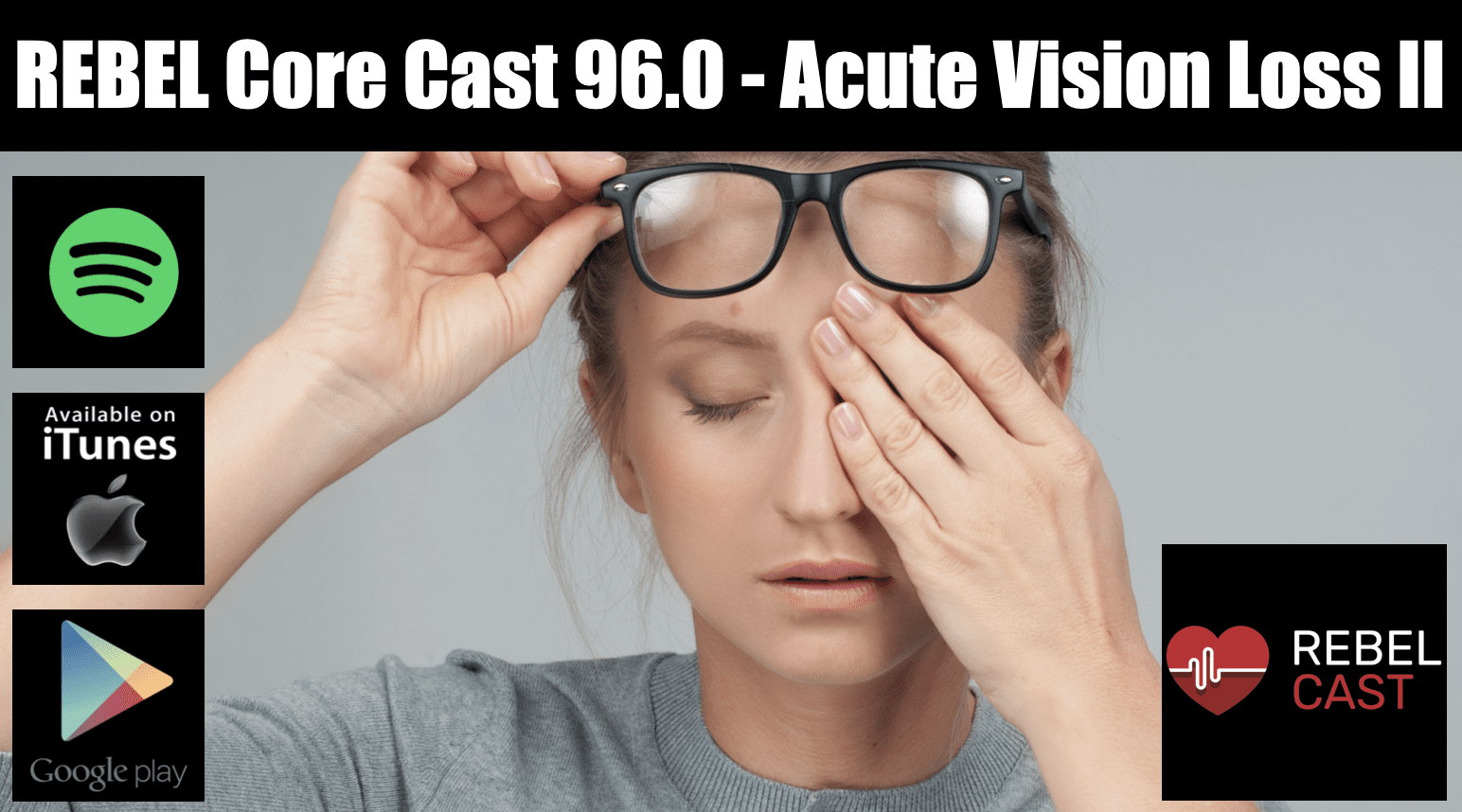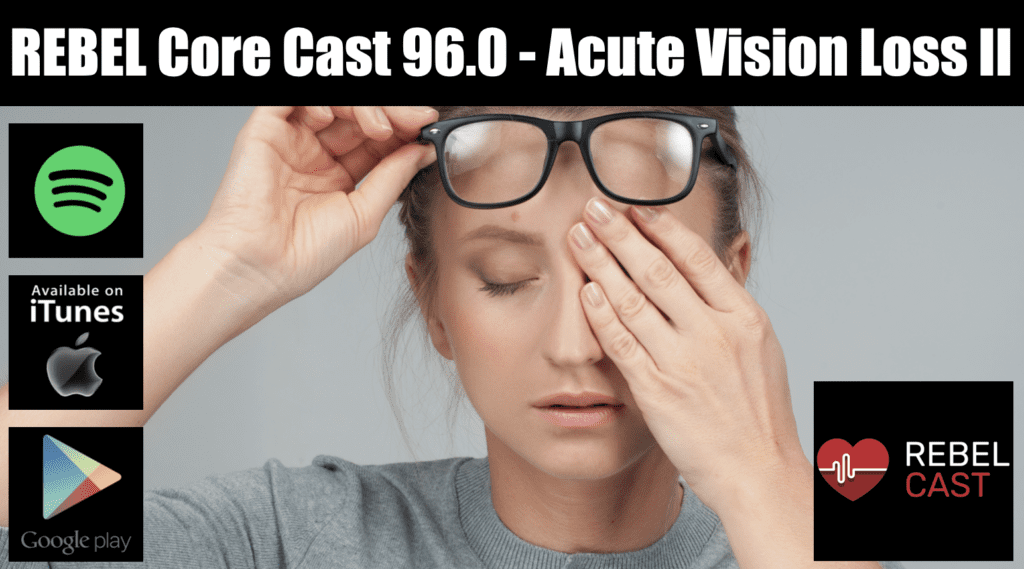
- Assess patients with floaters or flashers for retinal or vitreous detachment. Rapid diagnosis and emergency referral improves outcomes of ophthalmologic interventions.
- CRAO is a stroke of the eye; patients should be considered for a complete stroke work up.
REBEL Core Cast 97.0 – Acute Vision Loss II
Definition: Decrease of visual acuity due to a non-traumatic cause. Transient vision loss defined as vision loss <24 hours. Persistent vision loss defined as loss of vision >24 hours. (Bagheri 2015).
Causes: There are multitude of causes of vision loss. This post focuses on the following pathologies:
- Glaucoma
- Giant Cell Arteritis
- Vitreous Detachment
- Retinal Detachment
- Central Retinal Vein Occlusion
- Central Retinal Artery Occlusion
- Amaurosis Fugax
Vitreous Detachment (Guluma 2018)
Definition: Separation between the posterior vitreous cortex and the internal limiting membrane (ILM) of the retina (which is the most external portion of the retina).
Background
- Risk factors – Increasing age, myopia (nearsightedness)
- Many older individuals have essentially asymptomatic vitreous detachments.
- Often occurs as the vitreous shrinks with increasing age, pulling away from the retina.
Symptoms
- Floaters > flashers
- No change in visual fields
- May have decreased visual acuity.
Signs
- Shafer’s sign (tobacco dust)
- May see a Weiss ring when the posterior vitreous (PV) detaches from the optic disc margin
- Visualization with ultrasound.
Emergency Department Management:
- Emergency ophthalmology consultation.
- Emergency surgical management indicated if concomitant retinal tear, vitreous hemorrhage, or retinal detachment.
Retinal Detachment (Hollands 2009)
Pathophysiology
- Posterior vitreous shrinks with advancing age (aka synchysis senilis), pulling on the retina.
- Pulling can cause tears in the retina (10-15% of the time) (Hollands 2009)
- Tear allows liquefied vitreous leaks in, causing the retina to separate from the retinal pigment epithelium (33-46% of the time) (Hollands 2009)
Symptoms
- Blurry vision/decreased peripheral vision
- Flashers(photopsia)/floaters
- 14% of pts referred to ophthalmology with flashers/floaters end up having retinal tears.
- Photopsia is from vitreoretinal traction, floaters are from vitreous cells/blood in the eye.
- Symptom characteristics (Hollands 2009)
- Any flashers/floaters: (+) LR 1.2 and (–) LR 0.9.
- >10 floaters, (+) LR 8.1-36
Signs
- Pigmented cells (‘‘tobacco dust’’ aka Shafer’s sign) in the vitreous and occasionally in the anterior chamber (caused by pigmented epithelial cells that spilled into vitreous)
- Visual field loss
- Vitreous hemorrhage: (+) LR 10
- Visualization on ultrasound
Emergency Department Management
- Emergency ophthalmology consultation for possible surgical repair
Central Retinal Vein Occlusion (CRVO) (McAllister 2012)
Background
- Pathophysiology not fully understood; possibly due to thrombus located in the central retinal vein (CRV), in the region of the lamina cribrosa
- Second most common cause of vision loss due to retinal vascular disease (Most common cause: Diabetic retinopathy)
Symptoms
- Floaters – CRVO can cause neovascularization which causes leaky vessels leading to debris in vitreous.
- Blurry vision
- Glaucoma symptoms – due to leaky vessels.
- May be asymptomatic
Signs
- Visual acuity deficit – Variable degree.
- Funduscopic exam-
- Flame-shaped, dot and blot hemorrhages
- Retinal edema: May be limited to a certain section of the retina (if branch occlusion) or in all quadrants (if central vein occluded) (aka pizza pie eye)
- May have macular edema
Emergency Department Management
- Ophthomology consultation
- Treatment traditionally laser for neovascularization complications, although newer treatments are emerging.
Central Retinal Artery Occlusion (CRAO)
Background
-
- Anatomy: First branch of the internal carotid artery is the ophthalmic artery which splits into the posterior ciliary and central retinal arteries which supply the eye.
- Causes:
- Carotid artery stenosis (most common)
- Cardioembolic sources also important cause.
Symptoms
- Sudden painless monocular vision loss
- May have some temporal sparing.
Signs
- APD in affected eye
- Funduscopic exam: Whitening of ischemic inner retinal layers with sparing in the foveal region (which is supplied by the intact choroidal circulation) creating the classic “cherry-red spot”
Emergency Department Management
- Emergency ophthalmology consult, stroke work-up
- Treatment options:
- No clinical trials have demonstrated improvement with any treatment compared with observation.
- Management options described in the literature
- Tissue plasminogen activator (tPA)
- Ocular massage
- Ocular pressure lowering agents / maneuvers
- Topical agents such as timolol
- IV agents such as acetazolamide or mannitol
- Anterior chamber paracentesis
- Vasodilatory Agents (nitroglycerin, pentoxifylline, isosorbide, carbogen, breathing into a bag – causes increase in CO2 leading to vasodilation)
Read More
Bhatia K, Sharma R: Eye Emergencies in Adams J.G. et al, Emergency Medicine Clinical Essentials ed 2. Philadelphia: Elsevier, 2013 (Ch) 26: p. 209-225
Walker R, Adhikari S.: Eye Emergencies, in Tintinalli J et al (eds): Tintinalli’s Emergency Medicine: A Comprehensive Study Guide, Seventh Edition New York City: McGraw-Hill 2016 (Ch) 241
Guluma K, Lee JE. Ophthalmology, in Marx J et al (eds): Rosens Emergency Medicine: Concepts and Practice, ed 9. Philadelphia: Elsevier, 2018 (Ch) 61: p. 790-819
Core Ultrasound: Vitreous vs Retinal Detachment
Post Created By: Anand Swaminathan MD, MPH
Post Peer Reviewed By: Salim R. Rezaie, MD (Twitter: @srrezaie)




